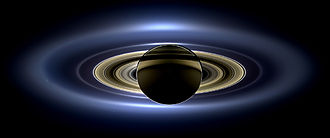
Back Saturnus se ringe AF حلقات زحل Arabic Aniellos de Saturnu AST Saturnun halqaları AZ زوحل حلقهلری AZB Кольцы Сатурна BE Кольцы Сатурна BE-X-OLD Пръстени на Сатурн Bulgarian སྤེན་པའི་གདུབ་ཀོར། BO Saturnovi prstenovi BS

The rings of Saturn are the most extensive and complex ring system of any planet in the Solar System. They consist of countless small particles, ranging in size from micrometers to meters,[1] that orbit around Saturn. The ring particles are made almost entirely of water ice, with a trace component of rocky material. There is still no consensus as to their mechanism of formation. Although theoretical models indicated that the rings were likely to have formed early in the Solar System's history,[2] newer data from Cassini suggested they formed relatively late.[3]
Although reflection from the rings increases Saturn's brightness, they are not visible from Earth with unaided vision. In 1610, the year after Galileo Galilei turned a telescope to the sky, he became the first person to observe Saturn's rings, though he could not see them well enough to discern their true nature. In 1655, Christiaan Huygens was the first person to describe them as a disk surrounding Saturn.[4] The concept that Saturn's rings are made up of a series of tiny ringlets can be traced to Pierre-Simon Laplace,[4] although true gaps are few – it is more correct to think of the rings as an annular disk with concentric local maxima and minima in density and brightness.[2] On the scale of the clumps within the rings there is much empty space.
The rings have numerous gaps where particle density drops sharply: two opened by known moons embedded within them, and many others at locations of known destabilizing orbital resonances with the moons of Saturn. Other gaps remain unexplained. Stabilizing resonances, on the other hand, are responsible for the longevity of several rings, such as the Titan Ringlet and the G Ring.
Well beyond the main rings is the Phoebe ring, which is presumed to originate from Phoebe and thus share its retrograde orbital motion. It is aligned with the plane of Saturn's orbit. Saturn has an axial tilt of 27 degrees, so this ring is tilted at an angle of 27 degrees to the more visible rings orbiting above Saturn's equator.

In September 2023, astronomers reported studies suggesting that the rings of Saturn may have resulted from the collision of two moons "a few hundred million years ago".[5][6]
- ^ Porco, Carolyn (2022-07-05). "Common Questions". CICLOPS Cassini Imaging Central Laboratory for Operations. Archived from the original on 2023-08-01. Retrieved 2022-09-22.
- ^ a b Tiscareno, M. S. (2012-07-04). "Planetary Rings". In Kalas, P.; French, L. (eds.). Planets, Stars and Stellar Systems. Springer. pp. 61–63. arXiv:1112.3305v2. doi:10.1007/978-94-007-5606-9_7. ISBN 978-94-007-5605-2. S2CID 118494597. Retrieved 2012-10-05.
- ^ Iess, L.; Militzer, B.; Kaspi, Y.; Nicholson, P.; Durante, D.; Racioppa, P.; Anabtawi, A.; Galanti, E.; Hubbard, W.; Mariani, M. J.; Tortora, P.; Wahl, S.; Zannoni, M. (2019). "Measurement and implications of Saturn's gravity field and ring mass". Science. 364 (6445): eaat2965. Bibcode:2019Sci...364.2965I. doi:10.1126/science.aat2965. hdl:10150/633328. PMID 30655447. S2CID 58631177.
- ^ a b Cite error: The named reference
history_of_the_ringswas invoked but never defined (see the help page). - ^ Cite error: The named reference
NYT-210230928was invoked but never defined (see the help page). - ^ Cite error: The named reference
TAJ-20230927was invoked but never defined (see the help page).